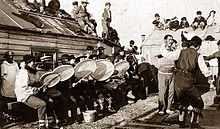
Back دين الإنويت Arabic Митология на инуитите Bulgarian Mitologia inuit Catalan Inuitská mytologie Czech Inuitisk religion Danish Inuit-Mythen German Mitología inuit Spanish Inuit mitologia Basque اسطورهشناسی اینوئیت Persian Mythologie inuite French

| Indigenous peoples in Canada |
|---|
 |
|
|
Inuit religion is the shared spiritual beliefs and practices of the Inuit, an indigenous people from Alaska, northern Canada, parts of Siberia, and Greenland. Their religion shares many similarities with some Alaska Native religions. Traditional Inuit religious practices include animism and shamanism, in which spiritual healers mediate with spirits.[1] Today many Inuit follow Christianity (with 71 percent of Canadian Inuit identifying as Christian as of 2021[update]);[2] however, traditional Inuit spirituality continues as part of a living, oral tradition and part of contemporary Inuit society. Inuit who balance indigenous and Christian theology practice religious syncretism.[3]
Inuit cosmology provides a narrative about the world and the place of people within it. Rachel Qitsualik-Tinsley writes:
The Inuit cosmos is ruled by no one. There are no divine mother and father figures. There are no wind gods and solar creators. There are no eternal punishments in the hereafter, as there are no punishments for children or adults in the here and now.[4]
Traditional stories, rituals, and taboos of the Inuit are often precautions against dangers posed by their harsh Arctic environment. Knud Rasmussen asked his guide and friend Aua, an angakkuq (spiritual healer), about Inuit religious beliefs among the Iglulingmiut (people of Igloolik) and was told: "We don't believe. We fear." Authors Inge Kleivan and Birgitte Sonne debate possible conclusions of Aua's words, because the angakkuq was under the influence of Christian missionaries, and later converted to Christianity. Their study also analyses beliefs of several Inuit groups, concluding (among others) that fear was not diffuse.[5]
First were unipkaaqs : myths, legends, and folktales which took place "back then" in the indefinite past (taimmani).[6]

- ^ Texts of mythology Sacred text.com. Retrieved 26 January 2013.
- ^ "Religion by Indigenous Identity: Canada, Provinces and Territories". Statistics Canada. doi:10.25318/9810028801-eng.
- ^ "Inuit (Eschimo)". Archived from the original on 2008-12-20. Retrieved 2008-12-31.
- ^ Qitsualik, Rachel Attituq (10 September 1999). "Shooting the Breeze". www.nunatsiaq.com. Nunatsiaq News. Retrieved 16 May 2024.
- ^ Kleivan & Sonne 1985: 32
- ^ Lowenstein 1992: p. xxxv